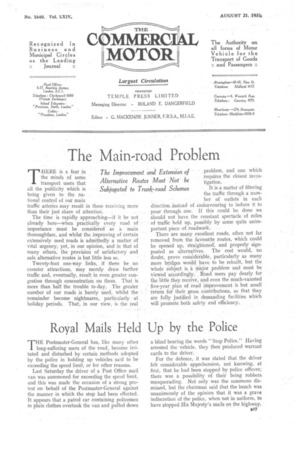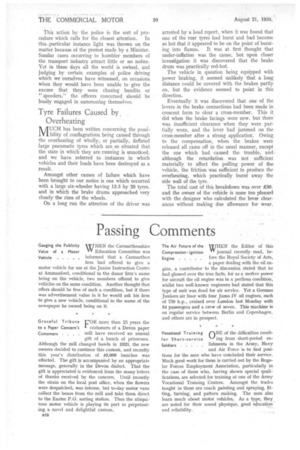Royal Mails Held Up by the Police
Page 31

Page 32

If you've noticed an error in this article please click here to report it so we can fix it.
THE Postmaster-General has,, like many other long-suffering users of the road, become irritated and disturbed by certain methods adopted by the police in holding up vehicles said to be exceeding the speed limit, or for other reasons.
Last Saturday the driver of a Post Office mail van was summoned for exceeding the speed limit, and this was made the occasion of a strong protest on -behalf of the Postmaster-General against the manner in which the stop had been effected. -It appears. that a patrol car containing policemen in plain clothes overtook the van and pulled down a blind bearing the words " Stop Police." Having arrested the vehicle, they then produced warrant cards to the driver.
For the defence, it was stated that the driver felt considerable apprehension, not knowing, at first, that he had been stopped by police officers; there was a possibility of their being robbers masquerading. Not only was the summons dismissed, but the chairman said that the bench was unanimously of the opinion that it was a grave indiscretion of the police, when not in uniform, to have stopped His Majesty's mails on the highway. This action by the police is the sort of pro cedure which calls for the closest attention. In this particularinstance light was thrown on the matter because of the protest made by a Minister. Similar cases occurring to humbler members of the transport industry attract little or no notice. Yet in these days all the world is awheel, and judging by certain examples of police driving which we ourselves have• witnessed, on occasions when they would have been unable to give the excuse that they were chasing bandits or "speeders," the officers concerned should be busily engaged in summoning themselves.
Tyre Failures Caused by Overheating MUCH has been written concerning the possibility of conflagrations being caused through the overheating of wholly, or partially, deflated large pneumatic tyres which are so situated that the state in which they are running is unnoticed, and we have. referred to instances in which vehicles and their loads have been destroyed as a result.
Amongst other causes of failure which have been brought to our notice is one which occurred with a large six-wheeler having 13.5 by 20 tyres, and in which the brake drums approached very closely the rims of the wheels. On a long run the attention of the driver was arrested by a loud report, when it was found that one of the rear tyres had burst and had become so hot that it appeared to be on the point of burst ing into flames. It was at first thought that under-inflation was the cause, but upon closer investigation it was discovered that the brake drum was practically red-hot. The vehicle in question being equipped with power braking, it seemed unlikely that a long distance could be covered with the brakes partly on, but the evidence seemed to point in this direction. Eventually it was discovered that one of the levers in the brake connections had been made in crescent form to clear a cross-member. This it did when the brake facings were new. but there was insufficient clearance when they were partially worn, and the lever had jammed on the cross-member after a strong application. Owing to the compensation, when the brakes were released all came off in the usual manner, except the one which had caused the trouble, and although the retardation was not sufficient materially to affect the pulling power of the vehicle, the friction was sufficient to produce the overheating, which practically burnt away the side wall of the tyre. The total cost of this breakdown was over £50, and the owner of the vehicle is none too pleased with the designer who calculated the lever clearances without making due allowance for wear.




























































































